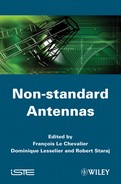Introduction 1
Antennas technologies and concepts are moving forward rapidly, in relation to different factors:
– evolution of primary technologies, such as metamaterials, or MMIC;
– continuous evolution of signal processing, both in terms of algorithms and computing power, opening the way to the implementation of new sensor concepts, or to smart exploitation of low-cost sensors (deformable antennas, for instance);
– evolution of requirements and applications, i.e. with the advent of multifunction antennas, terahertz antennas, or satellite reception on the move.
In order to review and discuss those recent advances, a workshop was organized in January 2009 by SEE and Groupement de Recherche “Ondes” (Research Group “Waves”) from CNRS, in France. This book, prepared after these exchanges, surveys the areas of new concepts and systems, emerging technologies, applications and processing techniques for detection and localization, and ultra-wideband systems. Though obviously not exhaustive, this review deals with most of the current problematics in this lively technical and scientific domain, at the core of future sensor design.
This wide field of activity will be explored here from four different perspectives, which have been organized into separate parts. Though somewhat arbitrary, this variety of view points will hopefully provide a global insight in the essential issues and advances, with the following chapters:
Part 1. Emerging Concepts: different transmit/receive architectures considered from the spatial exploration perspective, in radio-communication, acoustics, detection and localization:
– Joint Diversity and Beamforming for Downlink Communications;
– Acoustic Antennas for Biomedical and Industrial Ultrasonic Imaging,
– Space-time Exploration for Airborne Radars,
– Multifunction Antenna System Concepts, as an Opportunity for Ultra-wideband Radars.
Part 2. Technologies: some core technologies for optimization and integration of antennas:
– From a Molecule to an Electro-optic Antenna;
– Terahertz Broadband Micro-antennas for Continuous Wave Imaging;
– Dual Frequency Millimeter Feed;
– Reconfigurable Printed Antennas;
– Wideband Antennas and Artificial Magnetic Conductors;
– High Impedance Surface Close to a Radiating Dipole.
Part 3. Detection/Localization: specific analysis of a wide range of applications, from communications to automatic landing and navigation:
– Airborne High Precision Location of Radiating Sources;
– Multifunction Airborne Antennas;
– Active Sonar: Port/Starboard Discrimination on Very Low Frequency Triplet Arrays;
– Advanced Processing for DOA Estimation;
– Ground-based Deformable Antennas;
– Automatic Take-off and Landing System;
– Anti-jamming for Satellite Navigation.
Part 4. Ultra-wideband (UWB): techniques and methods for ultra-wideband antenna systems design:
– Ultra-wideband Antenna Systems;
– Co-design of Antenna and LNA for Ultra-wideband Application;
– Vector Spherical Harmonics Decomposition of Antenna Radiation Function for Fast Implementation in UWB Propagation Channel RT Simulation Tools.
This survey should illustrate the wide variety of technologies, just emerging now or already mastered, based on different physical principles, which can now be combined together by the system designer and provide access to a wide range of functionalities.
This range of technologies opens the way to a wide variety of concepts, from integrated antenna systems to multifunction systems, relying on sophisticated information processing algorithms, often adaptive and increasingly spatio-temporal, on transmit and/or receive. These new techniques will be implemented in multiple applications, from body area networks or personal security to space remote sensing or airborne multifunction systems.
This domain of “non-standard” antennas can thus be seen as a melting-pot for incoming breakthroughs, relating environmental physics, core technologies, modern information processing and the wide spectrum of application areas, at the heart of a lively and innovating scientific and technical community.
1 Introduction written by François LE CHEVALIER.
